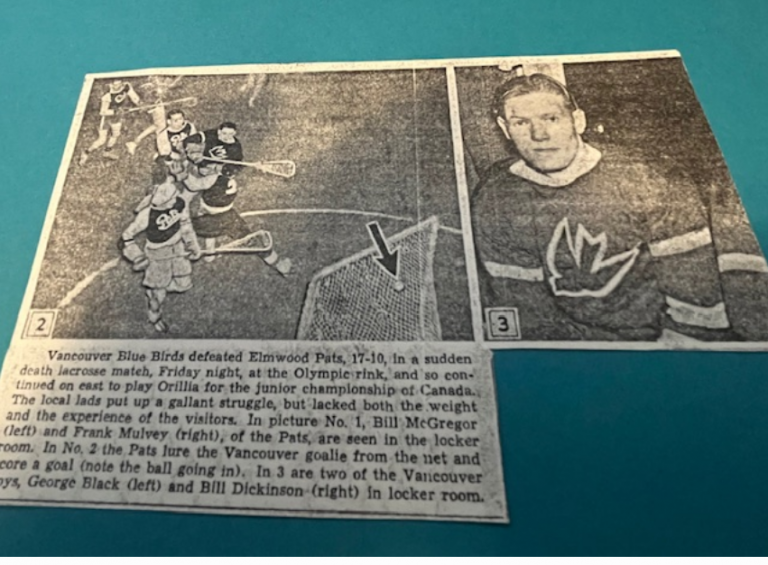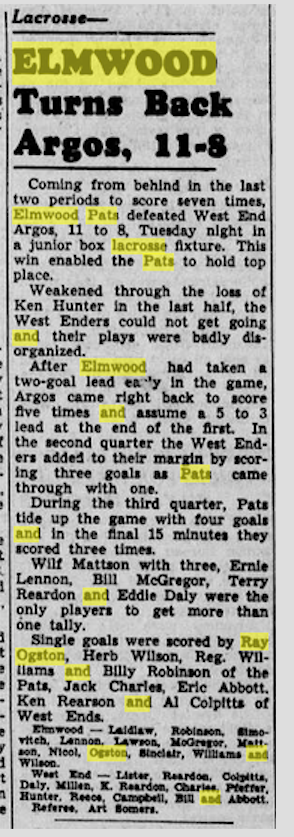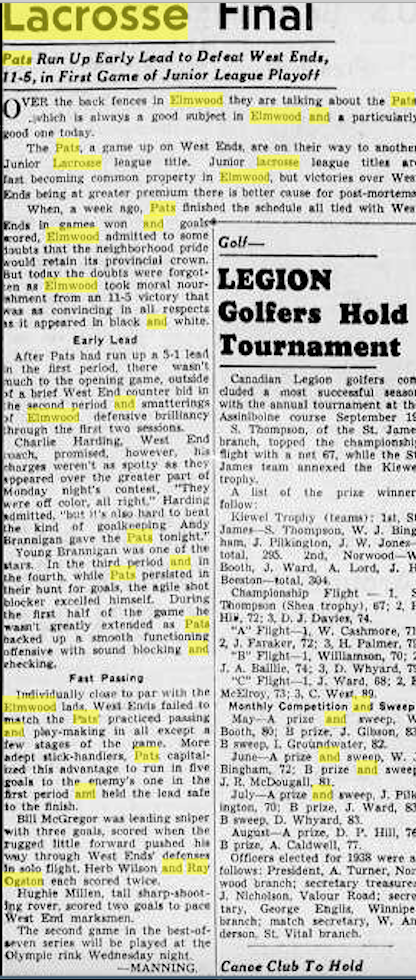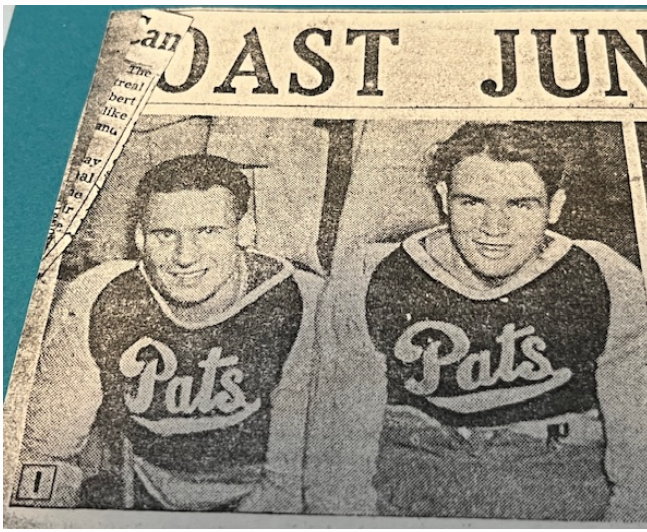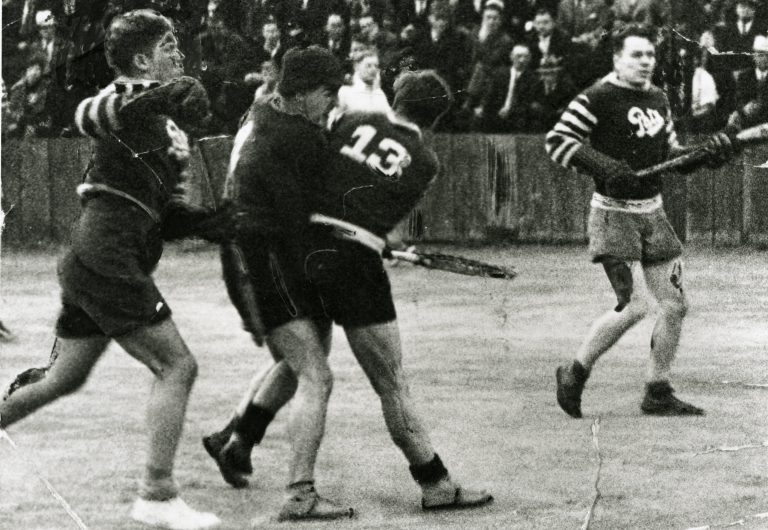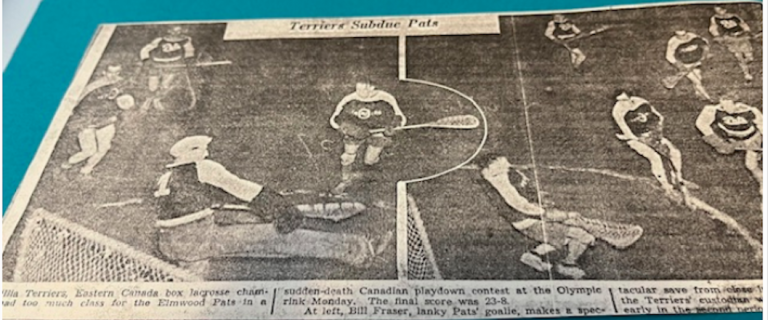MANITOBA MINTO CUP HISTORY- THE 1930'S
INTRODUCTION OF THE MINTO CUP PLAY DOWNS
In the twentieth century Canada began the change from a rural agricultural society to an urban industrialized nation. One facet of life that was significantly impacted was sport. As Canada became more urban, industrial workers and the new business class had “free time” to participate in sports. In the early part of the twentieth century sport was controlled nationally by the Amateur Athletic Union of Canada and locally the members of the private wealthy athletic clubs. Both these groups were staunch advocates of amateurism and they opposed the inclusion of these “lower class” rowdies in organized sports. The restrictive amateur codes imposed by these groups barred women, Indigenous People, Blacks, and Asians from participation in sport. In the 1930’s these restrictive policies led to a bitter split in amateur sports and ultimately lacrosse, hockey, and basketball walked out of the AAU. The Canadian Amateur Lacrosse Association (CALA) replaced the Dominion Lacrosse Association. One of most significant changes made by the CALA was the introduction of organized system of play downs for national championships at the junior and senior categories.
Prior to these change, national championships were adhoc in nature- with powerful clubs challenging the reigning national champion. Winnipeg based clubs (Winnipeg Lacrosse Club, Tammany Tigers, and Argonaughts) challenged for the Mann Cup (emblematic of the national senior lacrosse championship) from 1919 to 1932.
The Minto Cup donated by Governor General Minto in 1904. At first it was awarded to the senior national champions. In 1910 the BC professional senior league awarded the trophy to their league champions. It stayed there until in 1934, when the stewardship of the Cup was taken by the CALA. In 1937, the CALA instituted the first national play down for the Canadian junior championship and determined the prize would be the Minto Cup. This change meant Manitoba would have a place in the up coming national play downs.
In this system the winner of BC championship would travel east competing against each provincial champion. Only on occasion would there be teams from Alberta or Saskatchewan. However it was not uncommon for the BC champions to stop in these provinces to play a series of exhibition games. The gate receipts from these exhibition games were used to pay the travel costs of the BC team. The winner of the BC/ Manitoba series would travel on to play the Ontario/ Quebec champion. The next year the order was reversed with the Quebec champion travelling to Ontario, with the winner going on to compete against the Manitoba squad. The winner of this series would be declared Eastern Canadian Champions and travel on to BC for the Minto Cup.
1937 WESTERN CANADIAN CHAMPIONSHIPS
The first Minto Cup play down in Manitoba was a single game sudden death playoff played on October 22 at the Olympic Rink. The young Manitoba squad was lead by juvenile players Andy Brannigan in goal, Ray Ogston, Scotty Sinclair, and Johny Ames, bolstered by three experienced pick ups from the runner up West End team- Al Colpitts, Ken Hunter, and Hugh Millen. Hub Wilson, Jack Nicol, Reg Williams, Bill McGregor, and Ernie Lennon handled defence. Filling out the roster were Wilf Mattson, Frank Mulvey, and Moe Simovitch.
The Pat’s opposition the Vancouver Bluebirds, BC junior champions, were composed of 10 players who played in the BC senior loop the past season. The Bluebirds were led by senior players: Herbie Delmaico, Bob Lee, Ted Bradbury, and Chuck Morphitt. As if not having a roster full of players with senior experience was not enough, the Bluebirds picked up 6 of the top players from the other teams in the BC junior league. This was a handicap for the young Manitoba squad who only had 5 players who have had senior experience and no experience competing on the national stage.
The inexperience and undersized Pats went toe-to-toe with the heavily favoured Blue Birds, falling 17 to 10 in the sudden death game. The difference in the game was not the lack of experience or size; it was Vancouver goalie Lloyd Preston. The Winnipeg Tribune described the goaltenders play as: “marvelous at every turn.” The stonewall put up by Preston allowed the B.Birds to get out to a quick 4-0 lead. The play of young Brannigan in the Pats’ net grew stronger and allowed the ‘Tobans an opportunity to make a game of it. From half way through the game and into the third period the Manitoba team played the western visitors even, sparked by a 3-goal performance by Wilf Mattson. Ultimately the Tribune described the game: “Elmwoods were beaten, trimmed by a fair margin, but by no means disgraced.”
The sell out crowd at the Olympic Rink left the game satisfied that they had witnessed some of the best lacrosse played in Winnipeg and with a glimmer of hope for better results in the coming years. The fans on their way out were heard grumbling: “Wait until net year.”
ORILLIA TERRIERS COME TO TOWN in 1938
After getting their “feet wet” in the 1937 play downs against the Vancouver Bluebirds, optimism was high for their 1938 visit by the Orillia Terrier- Ontario junior champions, who Defeated St. Catherines in the Ontario final.. This optimism was fueled by a highly competitive junior league play. In the two-team league, West Ends and the Elmwood Pats, split the games with seven wins a piece. What the scheduled lacked in variety was more than made up in the quality of play. The regular season play was followed up with a seven game series, that the Pats won 4 games to two. The coaches, Chuck Harding of the West Ends and Elmwood’s Reg McGraith had time to drill their teams, each developing units displaying smart team play. The feeling was that this might be one of the best-prepared teams, Manitoba has sent to a national competition.
The Pats roster made up juvenile and junior aged players: Andy Branigan, Dave Ross, Dick Watt, Ritchie Ward, Andy Mutar, Brownie Krochak, Jphnny Arondus, Bill Pearce, George Johnson, Andy Miller, Lloyd Sinclair, Morris Macalister, Bill McGill, and K. Lawson. After the playoffs the Pats added West End sniper Ken “Red” Hunter to their roster.
This optimism was tempered with the realization that Orillia had bolstered their championship squad with selection of all stars from the Ontario junior league. As well the Terriers were motivated to move on and play against the New Westminster Salmon Bellies, who poached five of the Dogs top players in the off-season.
From the paltry attendance (200 fans) at the first game of the two game total point series, it appears most local lacrosse fans felt that the Pats would be in over their heads against the skilled and experienced Ontario representative.
This was certainly true in the first game, where the smooth passing drilled offence ran the Winnipeg squad out of the Olympic Rink. The Terriers started fast taking control of the game from start to finish. Potting goals for the Pats were Norm Macalister (2), Craig Lawson (3), Red Hunter (2), Bill Peace (2), and John Arondus (1).
While the Winnipeg team lost, their play was much improved. Especially so in the third and fourth quarters where the ‘Peggers’ dominated play with the Terriers falling back into a defensive posture.
The results of these games highlighted the biggest challenge facing Manitoba lacrosse- playing against superior teams prior to the play downs. This has been a reoccurring theme for Manitoba lacrosse for the past 90 years. The development of top-flight talent in Winnipeg was further hindered when two of the provinces best players signed to play with Orillia Terriers.
But with the bulk of the Pats players being of juvenile age, hope springs eternal that these young bucks will lead Manitoba to inter-provincial victories.
The Eastern Canadian champs traveled directly to New West Minister where they soundly defeated by the Salmon Bellies.
SQUABBLE OVER MONEY ENDS MINTO CUP PLAY DOWNS
An often heard cliches is “History repeats in self”. This is certainly true in amateur sports where money is often the root cause of decisions that have longer term impact on the sport. This especially true in the game of lacrosse. Read the example below:
After Manitoba was out classed in their first two attempts (1937 and 1938) in the Minto Cup play downs- what could be worse? Not playing at all. Manitoba withdrew from the 1939 Minto Cup play downs in dispute over money. The CLA demanded that Manitoba lacrosse put up a $300.00 guarantee (that would be $6000.00 in todays money). Last year, Manitoba turned over the total gate receipts ($500.00) of the Minto ad Mann Cup games played in Winnipeg. The CLA wanted the receipts from the Minto Cup games as well as the guarantee.
To add insult to injury, the Manitoba team was described by Scott Young as “the best lacrosse team in history”. The team was the most experience squad Manitoba fielded- with the bulk of the players playing in the last two play downs. For the first time team ‘Toba was comprised almost entirely of junior aged players. In the first two go-rounds, the majority of the team were still of juvenile age. The league champion Pats were bolstered with half the West End squad- making this the most talented team to represent Manitoba.
Local lacrosse fans responded to the situation with rallies and protests- but to no avail- the CLA would not move from their demand of $300.00 guarantee. In response to the cancellation of the Mann Cup play down game in Winnipeg, the MLA responded by expanding the provincial senior championship to a five game series between the Elmwood Pats and the Wellingtons rather than the usual best of three final. To support the game of lacrosse, fans packed the stands at the old Olympic Rink- cheering as much for the game of lacrosse as their favourite team.
The future of interprovincial lacrosse for Manitoba was unclear. It was hoped that a deal could be worked out to resume Minto Cup play downs in Manitoba.

